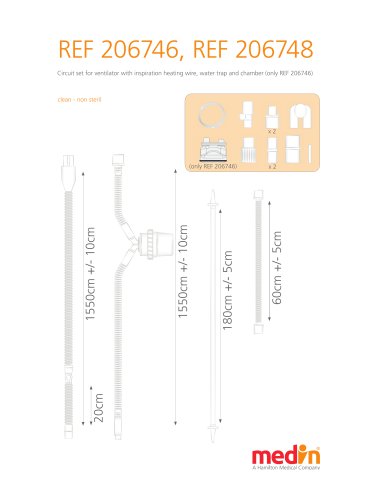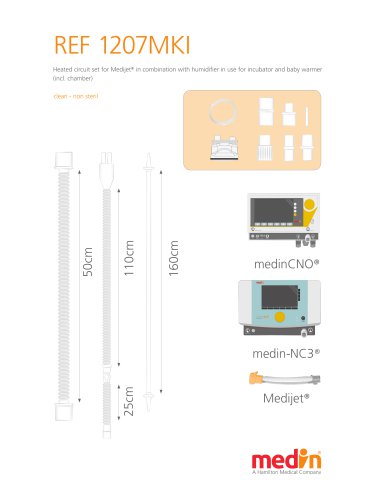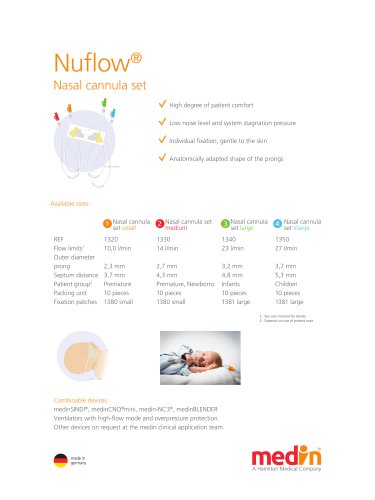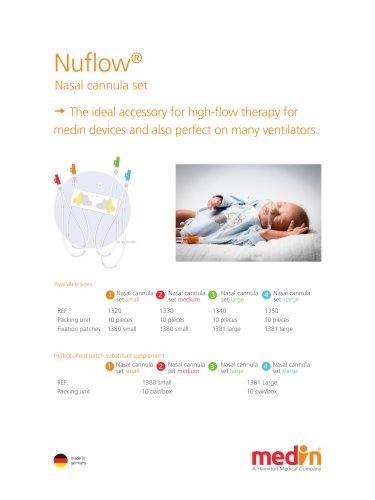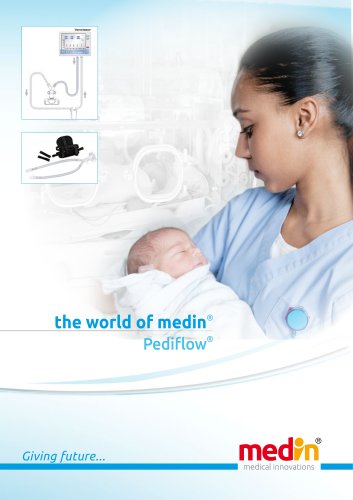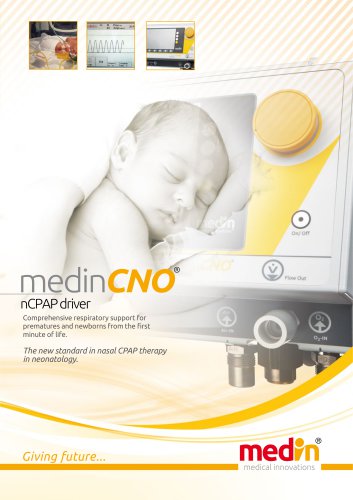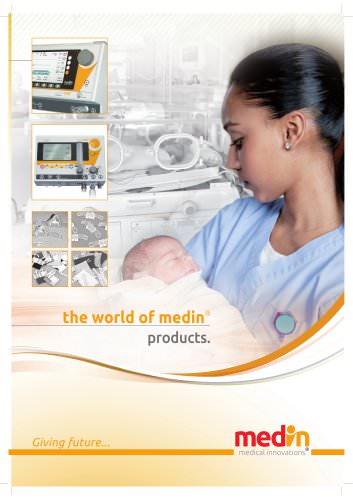
Catalog excerpts

A Hamilton Medical Company
Open the catalog to page 1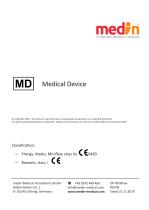
A Hamilton Medical Company Medical Device © Copyright 2018 - All contents, especially texts, photographs and graphics are copyright protected. All rights including duplication, publication, editing and translation are reserved, medin Medical Innovations GmbH — Prongs, Masks, Miniflow class IIa medin Medical Innovations GmbH @ +49 8142 448 460 OP Miniflow D- 82140 Olching, Germany www.medin-medical.com Stand 21.11.2019
Open the catalog to page 2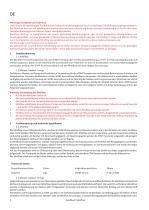
DE Warnung: Handbuch und Gebrauch Lesen Sie vor Verwendung der Produkte diese Gebrauchsanweisung genau durch und befolgen Sie die Anweisungen genauestens. Der Miniflow darf nur mit detaillierter Kenntnis über und unter Beachtung dieser Gebrauchsanleitung und nur für den unter Zweckbestimmung beschriebenen Zweck verwendet werden. Miniflow darf nur in Kombination mit einem passenden Beatmungsgerät oder einem geeignetem Wasserschloss mit Druckregeleinheit und einer geeigneten Patientenüberwachung verwendet werden. Die Masken, Prongs und Mützen dürfen nur in Kombination mit einem Miniflow...
Open the catalog to page 4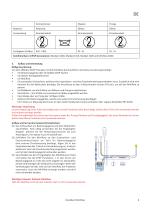
3. Aufbau und Anwendung Notige Ausrustung: Um eine effektive CPAP Therapie mit dem Miniflow durchzufuhren wird diese Ausrustung benotigt: • Ein Beatmungsgerat oder ein Bubble CPAP System • Ein passendes Schlauchset, welches eine Inspirations- und eine Exspirationsleitung enthalten muss. Zusatzlich wird eine Kammer fur den Befeuchter benotigt. Die Anschlusse an den Schlauchenden mussen F10 sein, um auf den Miniflow zu passen. • Ein Mafcband, um die Grofcen von Mutzen und Prongs zu bestimmen • Eine Mutze - ihre Grofce muss passend zum Baby ausgewahlt werden. • Eine Maske oder ein Prong der...
Open the catalog to page 5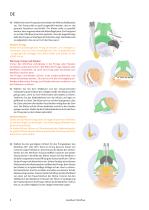
DE (4) Wählen Sie einen Prong oder eine Maske mit Hilfe des Maßbandes aus. Der Prong sollte so groß ausgewählt werden, dass er das gesamte Nasenloch verschließt. Die Maske sollte so gewählt werden, dass sie genau neben die Nasenflügel passt. Ein Prong wird so auf den Miniflow Generator gesteckt, dass die bogenförmige Seite des Prongs zur Oberlippe des Patienten zeigt. Die Maske wird so aufgesteckt, dass sie zur Form der Nase passt. Hinweis: Prongs Immer den größtmöglichen Prong verwenden, um Leckagen zu vermeiden und um einen bestmöglichen Sitz zu gewährleisten – je geringer die Leckagen...
Open the catalog to page 6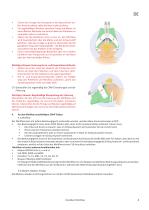
Führen Sie Prongs nicht komplett in die Nasenlöcher ein. Der Anschlussblock sollte die Nase nicht berühren. Ein regelmäßiger Wechsel zwischen Prong und Maske ist eine effektive Methode um Hautschäden am Patienten zu vermeiden oder zu reduzieren Ziehen Sie die Bändchen nicht zu fest an. Der Miniflow wird hauptsächlich über die Mütze und den Schaumstoff gehalten. Falls die Leckage zu groß ist, überprüfen Sie die gewählte Prong oder Maskengröße - die Bändchen fester anzuziehen löst das Problem nicht zwingend. Eine zu feste Befestigung der Bändchen oder ein zu weites Einführen der Prongs kann...
Open the catalog to page 7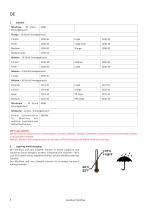
Warnung: Zubehor Der Miniflow funktioniert nur in Kombination mit diesen Masken, Prongs und Mutzen, andernfalls kann die korrekte Funktion nicht garantiert werden. Mutzen, Masken und Prongs konnen nur mit den nCPAP Generatoren Miniflow kombiniert werden. 6. Lagerung und Entsorgung Der Miniflow und sein Zubehor mussen in einem sauberen und trockenen Raum gelagert werden. Temperaturen zwischen -30°C und 70°C haben keinen negativen Einfluss auf den Miniflow oder das Zubehor. Der Miniflow und sein Zubehor konnen im normalen Hausmull entsorgt werden. Handbuch Miniflow
Open the catalog to page 8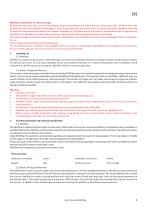
EN Warning: instructions for use and usage Read these instructions for use carefully before using these products and follow the instructions precisely. Miniflow may only be used by those with detailed knowledge of these instructions for use, which must be strictly observed. Miniflow may only be used for the purpose described in the chapter intended use. Miniflow may only be used in combination with an appropriate ventilator or a suitable surge tank with a pressure-regulating unit and appropriate patient monitoring. The masks, prongs and bonnets may only be used in combination with a...
Open the catalog to page 9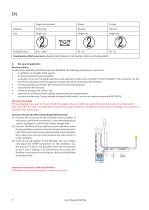
3. Set-up and application Necessary parts: To administer effective nCPAP therapy with Miniflow, the following equipment is necessary: • A ventilator or a bubble CPAP system • An active respiratory gas humidifier • a suitable circuit set including inspiratory and expiratory tubes and a chamber for the humidifier. The connectors at the end of the inspiratory and the expiratory tubes have to be 10 female to fit Miniflow. • A measuring tape to measure the necessary bonnet and prong size • a bonnet that fits the baby • a mask or prong of the correct size • optional for ventilators which require...
Open the catalog to page 10
EN (4) Select a prong or mask with the aid of the measuring tape. The prong should be selected such that it is large enough to seal the entire nostril. The mask should be selected such that it fits precisely along the sides of the nostrils. A prong is placed on the Miniflow generator such that the arched side of the prong points toward the patient’s upper lip. The mask is attached such that it conforms to the shape of the nose. Instruction: prongs and masks Always use the largest possible prong to avoid leaks and ensure the best possible positioning – the smaller the leak is, the higher and...
Open the catalog to page 11
EN Important instruction: prong and mask application • Do not insert the prongs fully into the nostrils. The connector block should not touch the nose. • Regularly switching between prong and mask is an effective method for avoiding or reducing damage to the patient’s skin. • Do not pull the straps too tight. The Miniflow is held primarily by means of the bonnet and the foam. If the leak is too large, check the selected prong or mask size – pulling the straps more tightly does not by itself solve the problem. • Excessively tightening the straps or inserting the prongs too far can lead to...
Open the catalog to page 12All Medin Medical Innovations GmbH catalogs and technical brochures
-
Nuflow®
2 Pages
-
Pb_1000_long
3 Pages
-
PB_medinBLENDER_1093_1094
2 Pages
-
OP_heated_circuits_all_languages
24 Pages
-
OP_Nuflow_all_languages
127 Pages
-
OP_Medijet
103 Pages
-
Pb_4000_long
3 Pages
-
OP Bubble
2 Pages
-
medin Company Brochure
16 Pages
-
Processing
4 Pages
-
Pb_20674X_short
2 Pages
-
Pb_20674X_long
3 Pages
-
Pb_1207_long
2 Pages
-
PB_1207MKI
2 Pages
-
PB_1207
2 Pages
-
OP_Blender_Rev09_all languages
115 Pages
-
Nuflow® Nasal cannula set
2 Pages
-
Promo Sheet Nuflow
2 Pages
-
Order Information Nuflow
2 Pages
-
OP_medinCNO_3090_REV12
68 Pages
-
OP Pediflow all languages
65 Pages
-
OP_medinCNOmini_3080_EN_Rev03
64 Pages
-
OP_medinSINDI_1080_REV14
36 Pages
-
Guideline_for_Transport_Rev06
20 Pages
Archived catalogs
-
medin Company Brochure
16 Pages
-
Flyer_medin_Rev04
2 Pages
-
Prospect_products_medin_Rev09
20 Pages
-
medinCNO®mini
4 Pages
-
MEDINsindi
2 Pages
-
Short_Application_Medijet_
2 Pages
-
Catalogue Pediflow®
4 Pages
-
Prospect_nasal_canula
4 Pages
-
Prospect_Miniflow_Bubble
4 Pages
-
Prospect_medinCNO
4 Pages
-
Medin_Catalog
16 Pages
-
Flyer_reuseable_bonnets
1 Pages
-
user_manual_medinSINDI
36 Pages
-
OP_Blender
18 Pages
-
OP_Circuits_heated
32 Pages
-
user_manual_medinCNO
59 Pages
-
OP_Miniflow_4000
96 Pages
-
OP_Medijet_1010_1020
4 Pages
-
OP_Medijet_1000
104 Pages
-
OP_Circuits_unheated
32 Pages
-
technical_data_medinSINDI
1 Pages
-
products_medin
16 Pages












